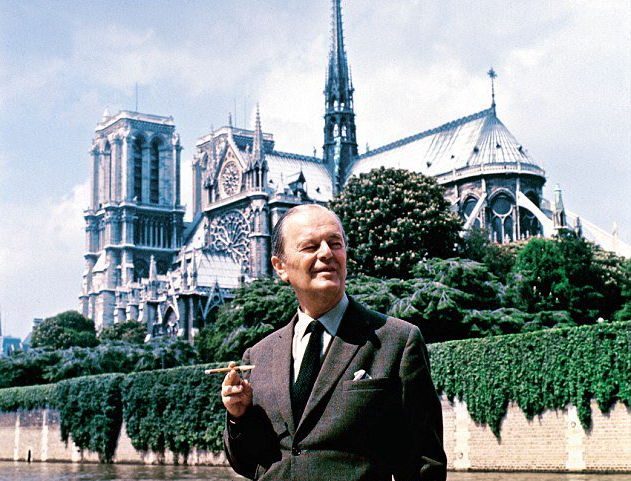
Art was fundamentally transformed in the 20th Century, as we saw last week. All the principles and assumptions upon which Kenneth Clark (above) had based Civilisation were challenged and often overthrown, and this process continued and intensified as the decades rolled by. Modernism emerged as the vanguard for a range of artistic and literary styles. Together, these constituted an ‘anti-civilisation’, characterised by a fanatical rejection of the core values, traditions, and conventions that had sustained Western Civilisation for over a millennium. Last week we identified the powerful forces that drove this transformation, and this week we bring our quest to an end, reviewing the cultural and artistic forces that confronted Clark as he prepared his epic series half a century ago.
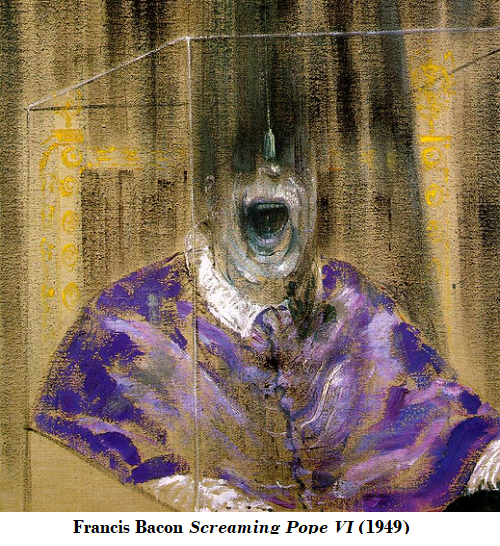
The End of Civilisation: Clark was writing and presenting Civilisation in 1968, at peak of the Cold War, which threatened global nuclear annihilation, with the USA and USSR each possessing literally tens of thousands of nuclear weapons. It was also less than a quarter-century after World War II, the most lethal war in history, with some 70-80 million dead, of whom two-thirds were civilians. Six million Jews were murdered by the Nazis, along with millions of other alleged Untermenschen, while 31 million people were permanently or temporarily relocated around Central Europe, including 14 million Germans. The war destroyed nations, tore societies apart, and initiated a long period of social, cultural, economic, and political upheaval that consumed millions more as the post-war decades unfolded.

Trauma: World War II left a seared scar across the cultural consciousness of the West. This was especially so in Europe, where trauma, austerity and angst reigned during the war and post-war years. Victory, peace, and hints of happiness were overshadowed by death camps, wartime atrocities, and the threat of the Atomic 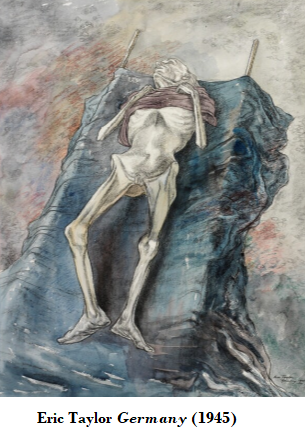 Bomb. Artists and writers turned in on themselves. In England, Cyril Connolly, a leading intellectual, observed as he announced the closure of Horizon, a major literary magazine:
Bomb. Artists and writers turned in on themselves. In England, Cyril Connolly, a leading intellectual, observed as he announced the closure of Horizon, a major literary magazine:
From now on an artist will be judged only by the resonance of his solitude and the quality of his despair
A new age of existential anxiety and cultural nihilism was dawning.
Nazi death camps: This new age was inaugurated by the carnage of war and the unspeakable atrocities in the Nazi death camps. These negated all human pretensions to spiritual nobility and stripped the human body of all dignity. In art this meant that the human figure was no longer conceived as noble, but as vulnerable, inconsequential and disposable.
Francis Bacon: The post-war artist who most typified this horrific collapse in values and revulsion at civilisation and humanity generally was Francis Bacon. Bacon depicted bodies in a truly brutal and monstrous manner. The great art historian, Herbert Read, declared that Bacon’s paintings were ‘symbols of a disintegrating world, of a paranoiac consciousness,’ and Bacon was particularly merciless and extreme in reducing bodies to the status of meat and carrion. His most famous work was the triptych, Three Studies for Figures at the Base of a Crucifixion (1944, below).
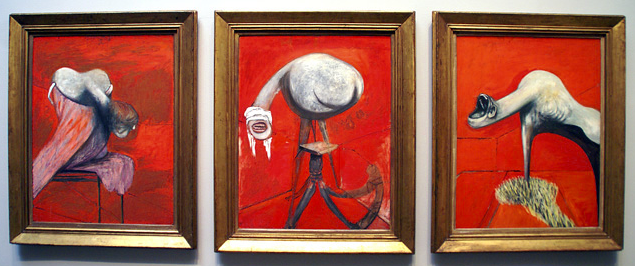
One critic observed that it displayed ‘a mindless voracity, an automatic unregulated gluttony, a ravening undifferentiated capacity for hatred.’ As art historian, Frances Spalding, acknowledged:
To a post-war audience, these ghoulish celebrants of murderous acts were a horrific reminder of human bestiality.
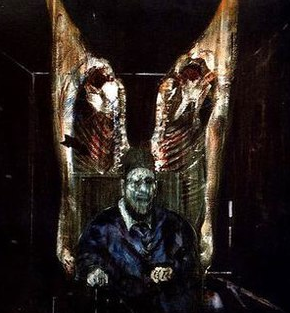
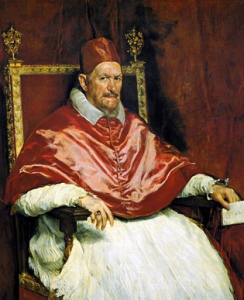 Figure with meat: An avowed atheist with a deep hatred of the Catholic Church, Bacon specialized in grotesque versions of traditional religious subjects, For example, Figure with Meat (1954, left) is based on a portrait of Pope Innocent X by Diego Velázquez (right), but depicts the Pope between two sides of beef.
Figure with meat: An avowed atheist with a deep hatred of the Catholic Church, Bacon specialized in grotesque versions of traditional religious subjects, For example, Figure with Meat (1954, left) is based on a portrait of Pope Innocent X by Diego Velázquez (right), but depicts the Pope between two sides of beef.
Crucifixion: Bacon also exploited the theme of crucifixion many times and produced three series on the subject, in 1944, 1962, and 1965. Each depicted the subject in terms of grotesque images of violent death and butchered bodies, hanging from hooks – reflecting the artist’s fascination with depicting the world as a slaughterhouse. Bacon’s message was explicit and ghastly: human beings are merely meat, merely matter as, e.g., in the ghastly central panel of Crucifixion (1965, below). He quickly became the most important British artist of the time.
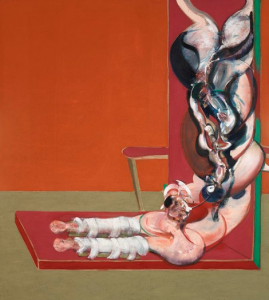
“The Paragon of Animals”? It seemed as if, in one fell swoop, the entire Renaissance and Humanist tradition had been destroyed: Hamlet’s words (Act II, Scene 2) were made to seem like an obscene parody:
What a piece of work is a man! how noble in reason!
How infinite in faculty!
In form and moving how express and admirable!
In action how like an angel!
In apprehension how like a god!
The beauty of the world! The paragon of animals!
And yet, to me,
What is this quintessence of dust?
Man delights not me:
No, nor woman neither
After clawing its way out of the mire 1000 years ago, it appeared that civilisation had come to a macabre dead-end.
 An Age of Anxiety: The post-war West had entered ‘the Age of Anxiety’, as W. H. Auden put it in his 1947 Pulitzer Prize-winning poem of that name. Auden explored the search for meaning and identity in a new, turbulent, urban-industrialized world. Indeed, huge challenges faced that world, including demobilizing millions of service personnel. In America there were 10.5 million veterans; in Australia, 600,000 (right). They all had to be integrated back into society, encountering a ‘normalcy’ many had seldom known and young families hardly known.
An Age of Anxiety: The post-war West had entered ‘the Age of Anxiety’, as W. H. Auden put it in his 1947 Pulitzer Prize-winning poem of that name. Auden explored the search for meaning and identity in a new, turbulent, urban-industrialized world. Indeed, huge challenges faced that world, including demobilizing millions of service personnel. In America there were 10.5 million veterans; in Australia, 600,000 (right). They all had to be integrated back into society, encountering a ‘normalcy’ many had seldom known and young families hardly known.
Alienation: Such challenges found expression in best-sellers like The Man in the Grey Flannel Suit (1955; film 1956). This traced the post-war life of a battle-hardened army captain as he struggled to adapt to hum-drum family life and a white-collar job, while being tortured by memories of murderous combat, and guilt over his Italian girlfriend and their child, whom he’d abandoned. But many veterans couldn’t integrate, and may have joined the ‘Beat Generation’ and Jack Kerouac On the Road (1957); or joined bikie gangs terrorizing ‘Middle-America’ as, e.g., in The Wild One (1953, below).
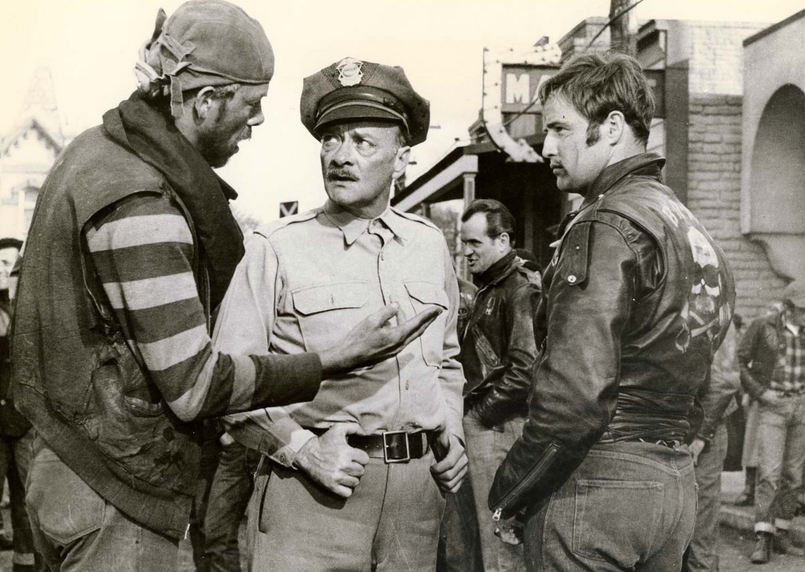
Generation Gap: But many more found themselves parents of ‘teenagers’, a new demographic whose name was only invented after the war. Soon they confronted the ‘generation gap’ and had the pleasure of dealing with their children’s ‘identity crises’ as, e.g., in Rebel Without a Cause (1955). This was another massively popular film that provided a ominous role model: ‘Jim Stark, a kid from a good family; what makes him tick … like a bomb!?’ Later, domestic life in suburbia proved much too boring for some and they welcomed temptations to which they might surrender as in Peyton Place (1956). Grace Metalious’s monster bestseller 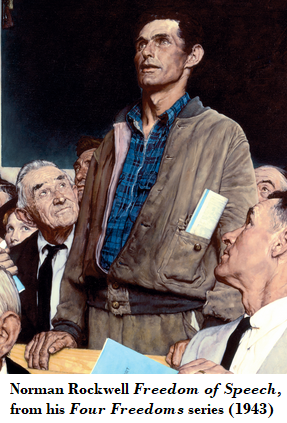 (and film and TV series) depicted the lives of three women struggling with their identities and desires in a small town world of gossip, hypocrisy, lust, adultery, betrayal, and murder.
(and film and TV series) depicted the lives of three women struggling with their identities and desires in a small town world of gossip, hypocrisy, lust, adultery, betrayal, and murder.
Norman Rockwell: It was never supposed to be like that. The mythic promise of the post-war era was captured by the brilliant popular artist, Norman Rockwell. His 4000 paintings included 400 cover illustrations for the Saturday Evening Post, covering every class and aspect of society. As Paul Johnson observed in Art: A New History, (2003, p.682):
It is hard to think of any other artist, of any nation or at any period, who painted, in such meticulous detail, so wide a selection of scenes, each carefully researched.
The Longing: The heartfelt desire communicated by such works was to put life back the way it was imagined before the war, to return to the warmth of family life, and recover and enjoy the ‘American Dream’.
The Reaction: This longing faced one crisis after another during the Cold War, and a second great force came into play as the adversary culture re-asserted itself, denouncing Rockwell’s sweet artistic vision 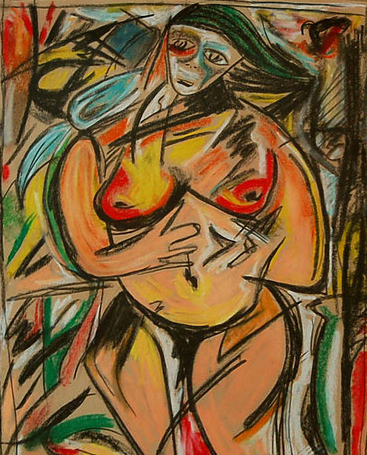 sentimental, cliché-ridden kitsch. The avant-garde ridiculed stable ‘homespun’ middle-class life, and offered images of chaos and confusion instead. Soon, artists were producing emphatically ‘non-Rockwell’ paintings: e.g., Willem de Kooning’s Woman series (1952-3, right). High art had intensified its war on ‘bourgeois’ popular culture.
sentimental, cliché-ridden kitsch. The avant-garde ridiculed stable ‘homespun’ middle-class life, and offered images of chaos and confusion instead. Soon, artists were producing emphatically ‘non-Rockwell’ paintings: e.g., Willem de Kooning’s Woman series (1952-3, right). High art had intensified its war on ‘bourgeois’ popular culture.
Invasion: This assault was led by the Modernist invasion of America. As world war had loomed in the late-1930s there had been an exodus of European artists and intellectuals to the US, where they found new patrons and markets, and laid the groundwork for a post-war cultural coup d’état. The exiled artists 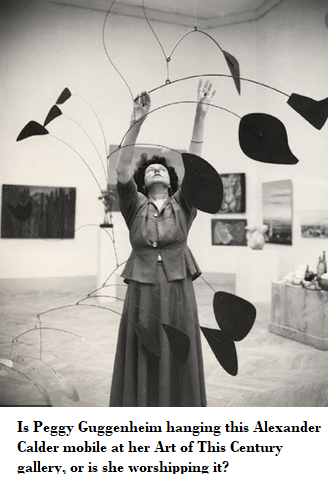 included many of the most famous Surrealists, e.g. Dali and Max Ernst. Ernst made certain of a new home by marrying Peggy Guggenheim, a rich American heiress and art collector with enthusiastic bohemian inclinations. She opened the ‘Art of This Century’ gallery in New York to promote the work of these ‘chosen’ exiles (and closed it when she and Max broke up).
included many of the most famous Surrealists, e.g. Dali and Max Ernst. Ernst made certain of a new home by marrying Peggy Guggenheim, a rich American heiress and art collector with enthusiastic bohemian inclinations. She opened the ‘Art of This Century’ gallery in New York to promote the work of these ‘chosen’ exiles (and closed it when she and Max broke up).
The New York Art System: Post-war, it became clear that New York had replaced Paris as the hub of international art and intellectual life. The American avant-garde seized centre stage. The key feature of the new art scene was the powerful dealer-gallery-critic system, underpinned by all-pervasive ‘Art Theory’, dominated by critics like Clement Greenberg and Harold Rosenberg, nurtured on Marxism and Existentialism. This closed system was another force transforming art: a closed elite of dealers nurtured, contracted, and promoted chosen artists and their works in a fiercely competitive market, where the only alternative was Federal Arts Project funding. Consequently, given these were the sole or principal sources of financial support, artists’ primary allegiances were to their agents, the gallery owners, the critics, the market, and the state.
Competing Styles: Kenneth Clark, who had built his reputation on decades of astute purchasing of Old Masters, witnessed the emergence of this artistic ‘survival of the fittest’ , a Darwinian nightmare of competing styles, the most prominent of which was Abstract Expressionism, followed later by Colour Field, Hard Edge, Op Art, Pop Art, Assemblage, Minimalism, Conceptualism.
The Painted Word: In true Modernist fashion, these styles all sought to ‘challenge the viewer’, with the implication that a failure to like a piece was a problem for the audience, not the artist. In turn, this made artists dependent upon lengthy and tendentious explanations to justify their products. This gave rise to what Tom Wolfe later debunked as The Painted Word (1975). It seemed that without a theoretical rationale and a critic to provide it there was no art object. This dependence upon ‘Theory’ transformed the nature of art at it very roots.
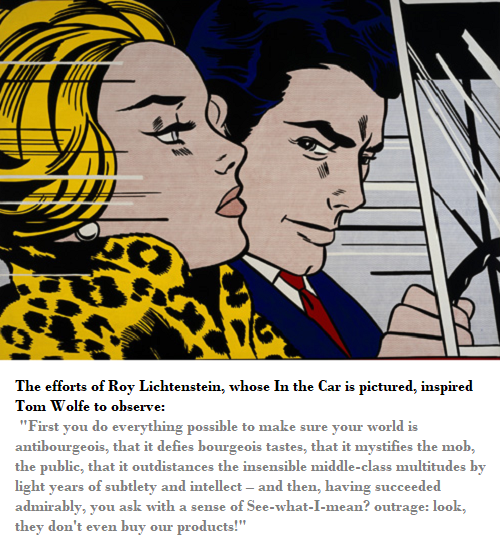
Sanctified Individuality: Moreover, the post-war art world came to place great emphasis on the allegedly unique individuality of the artist, which was elevated to an almost sacred status. Indeed, it was often this distinctive subjectivity, believed to be uniquely deep and meaningful, that increasingly became the subject of the work of art, rather than any external art object.
Marketing the Self: This hyper-subjectivism was yet another transformative force. It created tensions for artists operating within a capitalist market where their creations, incorporating what they projected as essential aspects of their own selves, were bought and sold just like any other commodities or investment.
The Existentialist Moment: Fortuitously for the system, this hyper-subjectivism found ideological 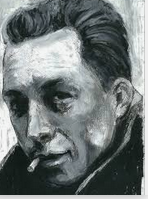 support in Existentialism, a hyper-subjectivist philosophy that dominated post-war culture from 1945 until c.1970, when it was overrun by postmodernism and other anti-humanist ideologies. The leading Existentialist was Jean-Paul Sartre, who famously concluded in No Exit (1944) that “Hell is other people.” Others included Simone de Beauvoir (The Second Sex, 1949); and (at right) Albert Camus (The Outsider, 1942; The Myth of Sisyphus, 1942; The Rebel, 1951), while Franz Kafka was the symbol of their alienation. The influential critic, Harold Rosenberg, made Existentialism central to all his commentary on art, especially his analysis of Abstract Expressionism.
support in Existentialism, a hyper-subjectivist philosophy that dominated post-war culture from 1945 until c.1970, when it was overrun by postmodernism and other anti-humanist ideologies. The leading Existentialist was Jean-Paul Sartre, who famously concluded in No Exit (1944) that “Hell is other people.” Others included Simone de Beauvoir (The Second Sex, 1949); and (at right) Albert Camus (The Outsider, 1942; The Myth of Sisyphus, 1942; The Rebel, 1951), while Franz Kafka was the symbol of their alienation. The influential critic, Harold Rosenberg, made Existentialism central to all his commentary on art, especially his analysis of Abstract Expressionism.
The Artist as Anguished Outsider: For artists struggling with their professional identity within capitalist society, the Existentialist formula was a crucial piece of good fortune. As Edward Lucie-Smith (Movements in Art Since 1945, 1969, pp.9-10), recounts, Existentialism promoted the view
that man was alone in the world, was detached from all systems of belief, and that artists must find their salvation in art alone, reinventing it from the very beginning.
It promoted artists to the status of prophetic outsiders and ratified their isolation from mundane, mainstream, ‘Norman Rockwell’ society. They assumed the status of heroic rebel, anguished and tortured by their encounter with the absurdity of existence in a godless world, but boldly communicating this experience through their (usually incomprehensible) work.
The Theatre of the Absurd: Aside from art, it was post-war theatre that gave these ideas their most powerful and influential expression. Taking a lead from Camus’ presentation of the absurdity of the human condition in The Myth of Sisyphus, playwrights began producing dramas that focused largely on the conviction that human existence has no meaning or purpose. The characters seem to be at the mercy of unknown, incomprehensible, ‘Kafkaesque’ forces that they neither control nor comprehend.
Waiting for Godot: Typically, in a commentary of modern life, they appear always to be waiting for something to happen as, e.g., in Waiting for Godot (1953) by Samuel Beckett (who had been another one of Peggy Guggenheim’s lovers). In general the Theatre of the Absurd was characterized by an absence of any significant plot or its resolution; unsympathetic characters; meaningless and repetitive action; inane and clichéd dialogue and wordplay; rudimentary sets and costumes, and an explicit rejection of all the conventions of traditional theatre. Oddly, confronting the audience with the claim that life was meaningless was presented by the avant-garde as a ‘liberating experience’.
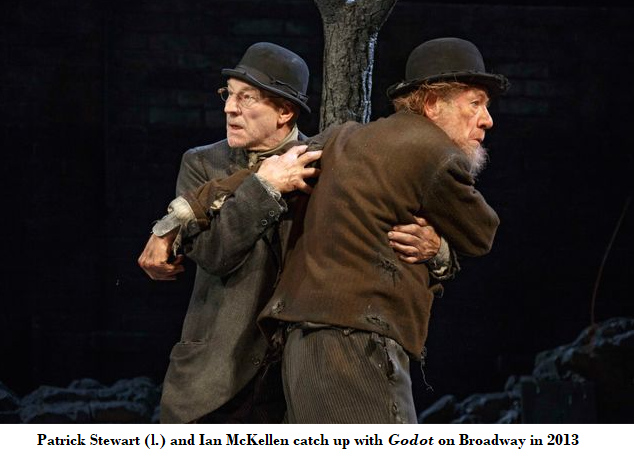
Abstract Expressionism: No art movement better communicated this existentialist/nihilist/absurdist cluster of ideas than Abstract Expressionism. The movement’s name was meant to distinguish its abstract, non-representational approach from the figurative and representational expressionism of the earlier 20th Century. It was pioneered by [clockwise from right] Ashile Gorky (e.g., Agony, 1947), Jackson Pollock (No.5, 1948), Willem de Kooning (e.g., Excavation, 1950, below), and Franz Kline (Painting No.2, 1954).
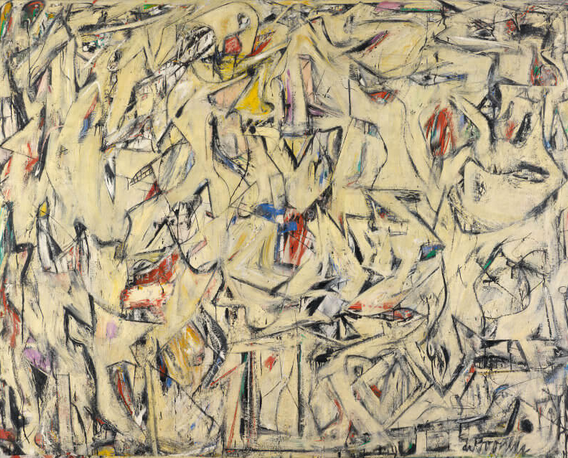
Action Painting: The emphasis in Abstract Expressionism was on the spontaneous action of the artist and the influence of the subconscious expressing itself. This was especially so with ‘action painting’ (a term coined by Rosenberg in 1952). According to the theory underlying this sub-style, the ultimate object of art is not the finished product but the creative action that brings it about — another transformative idea.
The Canvas as Stage: The canvas confronting the artist forms the ‘stage’ or ‘arena’ on which he performs as he practices the act of creation. The artist would stand on or beside the canvas, left un-stretched on the floor, while the paint is thrown, dripped, and splashed about, mixed with sand or broken glass, manipulated by brushstrokes, arm and wrist movements, and random gestures. The focus of the entire exercise, i.e., the actual work of art, was the action not the object ~ the finished painting is merely the physical record of the artist’s existential struggle with the creative impulse.
Concept Replaces the Object: Decades later, this approach was later taken to its extreme with Conceptual Art, where the concept is the work of art and the physical art object is just a by-product of the concept.
Jackson Pollock: The iconic practitioner of action painting was Jackson Pollock, who became the epitome of the existentially anguished hero-artist, plunging into the depths of the subconscious. As the key art critic, Harold Rosenberg pronounced, Pollock was engaged in
an adventure over depths in which he might find reflected the true image of his identity.
Films were made of him in action, while visitors or his wife, Lee Krasner, would come and watch (from a safe distance).
The CIA Secret of Success: It was not only this elaborate existentialist rationale that supported Abstract Expressionism and related styles in their rise to cultural pre-eminence; they were also heavily promoted by the US State Department and the CIA, as part of the decades-long ideological battle being waged between America and the Soviet Union.
The Cultural Cold War: This ideological confrontation was another massive force politicising art. Immediately after WWII, America was a superpower, leading the world economically and militarily. However, as the Cold War set in, it was realized that America must also vigorously assert herself culturally. This was especially so in light of the aggressive ideological challenge offered by the massive global 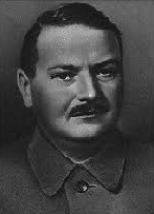 propaganda machine deployed by the Soviet Union. This operated under Andrei Zhdanov (left), Stalin’s brutal henchman, Chairman of the Cominform, and ‘director of terror’ on the cultural front of the Cold War across the globe.
propaganda machine deployed by the Soviet Union. This operated under Andrei Zhdanov (left), Stalin’s brutal henchman, Chairman of the Cominform, and ‘director of terror’ on the cultural front of the Cold War across the globe.
Zhdanovism: Soviet cultural policy under Zhdanov divided the world into two ‘blocs’ engaged in a titanic struggle where only one could survive: the ‘Imperialistic’ West bent on war, led by the USA; and the ‘Democratic’ peoples’ states dedicated to peace, led by the USSR. Every aspect of life was conditioned by this premise, especially culture. Zhdanovism meant that there was no such thing as ‘art for art’s sake’. It dictated that all Soviet artists, writers, film makers, cultural workers and intellectuals adhere rigidly to Marxism-Leninism, Socialist Realism, and the party line in all their work. This applied also to all foreign Communist Parties and their supporters. They were all also required to inform on any deviations from Socialist Realist orthodoxy.
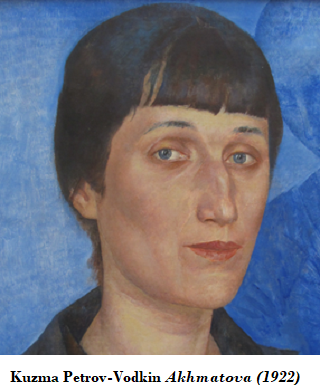 Consequences: Failure to obey all Soviet policy diktats attracted draconian criticism and punishment. For example, the leading Russian poet, Anna Akhmatova, was denounced for not sufficiently celebrating Soviet achievements. Her work was ridiculed as
Consequences: Failure to obey all Soviet policy diktats attracted draconian criticism and punishment. For example, the leading Russian poet, Anna Akhmatova, was denounced for not sufficiently celebrating Soviet achievements. Her work was ridiculed as
‘the poetry of a frenzied lady, dreaming between the boudoir and the chapel’, full of ‘amorous-erotic motifs’
and defeatist ‘doom and gloom’ about the USSR. The great Soviet composers, Dmitri Shostakovich, Sergei Prokofiev and Aram Khachaturian were punished for following Western trends, ‘misusing dissonance’, writing ‘hermetic music’, and being generally ‘counter-revolutionary’.
Wicked Cosmopolitanism: Writers, literary historians, and critics were denounced for suggesting that Russian authors had been influenced by Western ‘bourgeois’ writers like Jean-Jacques Rousseau, Byron or Charles Dickens. Such dissidents were accused of ‘cosmopolitanism’, i.e., of succumbing to bourgeois, counter-revolutionary, non-Soviet influences. Many artists simply ‘disappeared’, i.e., they really got cancelled!

‘The Triumph of American Painting’: It was in this dangerous, unstable, and intensely political context that Abstract Expressionism was made the artistic vanguard of modern American culture, going into battle with Socialist Realism and Zhdanovism. Pollock and Abstract Expressionism were vigorously promoted internationally as
the triumph of American painting, which spoke for what America was: vigorous, energetic, free-wheeling, and big. — F. S. Saunders, The Cultural Cold War
Pollock was depicted as ‘virility incarnate’, an inveterate womanizer and a drunk – the typical vices of the tortured modern artist. Consequently,
Ecstatic, loose, fuelled by drink, Modernism in Pollock’s hands was a kind of tremendous delirium.
Pollock died in 1956 in a DUI accident that also killed a girlfriend but left his mistress alive.
Irony: Ironically, Modernist art was just as unpopular in the United States as it was in the Soviet Union. It was not understood by the masses, and had been denounced in Congress as subversive and ‘socialistic’, and even President Truman (a genuine art lover) rejected it. Federal funding for major exhibitions of Modernist art was cut off. Nevertheless, Abstract Expressionism with Pollock in the vanguard was chosen by the CIA to compete with Socialist Realism on the international stage, as representing all that was laudable in free-enterprise liberal democracies: ‘It was seen to uphold the great American myth of the lone voice, the intrepid individual,’ the prophet speaking out. However, the Soviets simply denounced Abstract Expressionism as proof of capitalist decadence.

Blue Poles Pollock’s Blue Poles (1952, above) was an excellent example of Abstract Expressionism. It is also an outstanding example, not only of the influence of the CIA, but of the art market as a major investment vehicle. It was purchased amid great controversy by the National Gallery of Australia in 1973 for $1.3 million; its present value has been estimated at $350 million, making it one of the most valuable paintings in the world (perhaps it could be sold to pay down debt).
Figuration vs Abstraction Down Under The Australian art world at this time provides a case-study of the impact of this ideological struggle. There was already tension between two basic aesthetic positions, 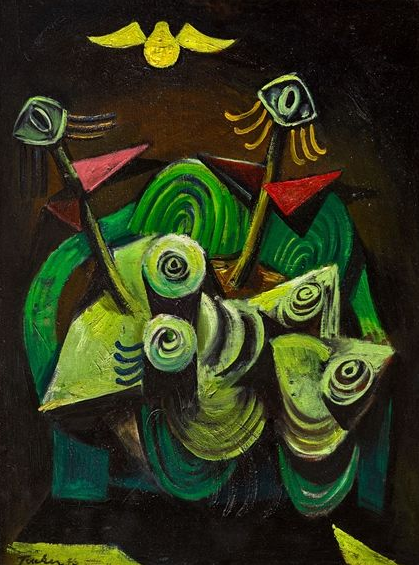 already identified by Clark and the controversy that he provoked in 1935, as we have seen. These concerned figuration or representational art versus abstraction or non-representational art. The former viewed their work in terms of the person, society, and history, always located within time and space; the latter viewed the artist in individualistic terms and their subject matter as universal themes, outside time and space. To make it more complicated, this situation was overlaid by the strictures of Socialist Realism, which not only condemned abstraction and individualism, but insisted on naturalistic forms of representation. Consequently, during the war leading artists like Sidney Nolan and Albert Tucker (e.g., Images of Modern Evil 29, pictured at right) were denounced by Socialist Realists as Fascists.
already identified by Clark and the controversy that he provoked in 1935, as we have seen. These concerned figuration or representational art versus abstraction or non-representational art. The former viewed their work in terms of the person, society, and history, always located within time and space; the latter viewed the artist in individualistic terms and their subject matter as universal themes, outside time and space. To make it more complicated, this situation was overlaid by the strictures of Socialist Realism, which not only condemned abstraction and individualism, but insisted on naturalistic forms of representation. Consequently, during the war leading artists like Sidney Nolan and Albert Tucker (e.g., Images of Modern Evil 29, pictured at right) were denounced by Socialist Realists as Fascists.
Escape Route: In this context, Australian Abstract Expressionists rejected social and political concerns and eagerly adopted the outsider/individualistic paradigm underlying the new school:
In contrast to the collective spirit that animated the art of the war years, abstraction drew on a romantic conception of the artist as a solitary creator.
This not only made it possible to avoid the dogmatic strictures of Socialist Realist School, it also allowed artists to act as virtuosos of ‘high art’, insulated and above the ‘lowbrow and middlebrow culture’ of the masses (Art in Australia, p.155).
You Beaut Country: Prominent examples of Australian works in the Abstract Expressionist style include: John Olsen, Summer in You Beaut Country, (1962); and Frank Hodgkinson, e.g., A Garden of Earthly Delights (1964-65); while one of the more interesting Abstract Expressionists in Australia was Ian Fairweather. Born in Scotland he travelled all over Asia and Oceania, spent years as a prisoner in a Japanese POW camp, and lived as a hermit in a shed on Bribie Island. His most famous painting is Monastery (1961; below).
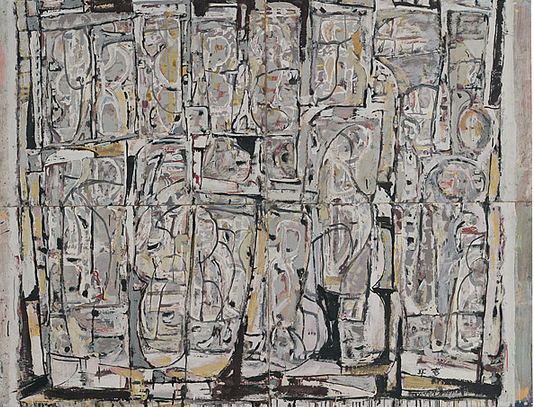
Fred Williams: One Australian artist whose work proceeded from a figurative stance but approached an Abstract Expressionist outcome via a long-term meditation on the Australian landscape was Fred Williams, e.g., with Upwey Landscape II (1961, below).
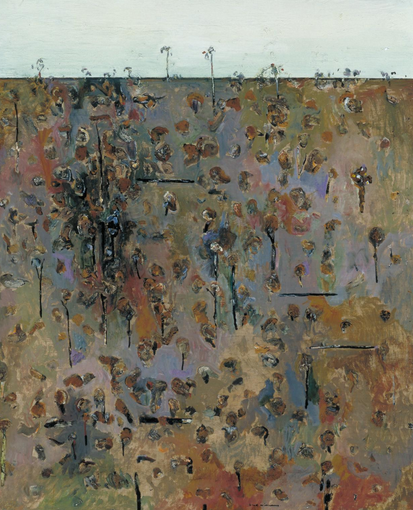
Resistance & Controversy: Other leading Australian artists resisted the trend to total abstraction and persisted with the figurative painting tradition, capturing aspects of Australian life in both the city and the 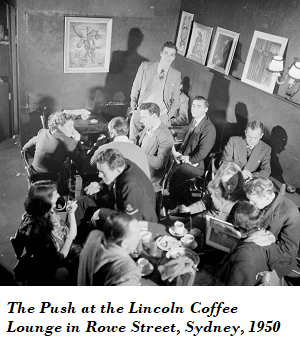 outback. This led to a bitter controversy, based on the traditional Sydney-Melbourne cultural rivalry.
outback. This led to a bitter controversy, based on the traditional Sydney-Melbourne cultural rivalry.
The Sydney Push: Like contemporary Progressivists, Sydney artists and critics were desperate to be ‘on the side of history’. They embraced the new abstract styles, denounced figurative work, and “enthusiastically spoke of the necessity to follow the current of history”, represented, they claimed, by Abstract Expressionism. The older style figurative work, e.g., Arthur Boyd’s ethereal Sleeping Bride (1957-8), was ridiculed by Sydney critics as “hill-billy” art (Christopher Allen, 1997, Art in Australia, pp.158, 161).
The Antipodeans: In response, Melbourne artists pushed back. In ‘one of the most famous and notorious events in Australian art history’ they formed an alliance called the Antipodeans. Apart from artists it included the pre-eminent Marxist art historian and ex-CPA member Bernard Smith. They promptly issued a manifesto defending figurative painting, and attacking the key claims of the Abstract Expressionists, i.e., that they were pioneering a higher, universal, or purer form of art; and that they could escape from history and society through art.
Emptiness & Isolation: Important figurative works from this period include Sidney Nolan’s iconic and sparse Ned Kelly (1946); Robert Dickerson’s evocative and sad The Tired Man (1956); John Brack’s hauntingly anomic Collins Street, 5pm (1956, below); and Jeffrey Smart’s bleak Cahill Expressway (1962). All of these works combined figurative abstraction with the perennial Australian artistic motifs of emptiness, isolation, anomie, and aloneness.
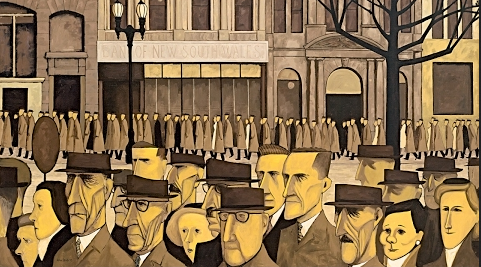
Overseas Trends: Meanwhile, overseas, the ruthless Darwinian struggle in the art world continued at an ever-accelerating pace. Driven by dealers, critics, and ambitious artists. There was a reaction against Abstract Expressionism in the 1950s as new combatants fought for power, but instead of returning to figurative and representational styles they pursued explicitly formalistic ‘post-painterly abstraction’, yet another transformative force.
Colour Field: This included Colour Field painting, producing large fields of solid colour painted on or stained into the canvas. The emphasis was on ‘flatness’, and the purity and consistency of the colour field,  with no intrusive evidence of the artist’s actions, gestures, or brushstrokes. According to this theory, the art object (e.g., in Mark Rothko’s No 61, 1953, right), was not action but purely the colour, which Rothko insisted had a ‘mystical’ significance.
with no intrusive evidence of the artist’s actions, gestures, or brushstrokes. According to this theory, the art object (e.g., in Mark Rothko’s No 61, 1953, right), was not action but purely the colour, which Rothko insisted had a ‘mystical’ significance.
Hard-Edge: Karl Benjamin’s Orange, Red, Umber (1958) typifies another ‘post-painterly’ style that fancied itself as a reaction against both Abstract Expressionism and Colour Field work. Hard-edge painting placed the emphasis on abrupt transitions between colour areas on the canvas. It also suppressed any element of artistic personality or spontaneity.
Op Art: Such extremely formalistic works led to Op Art, which depended upon optical illusions for its effect. Op Art tricks the eye into gaining a sense of movement, and of perceiving patterns that warp, swell, or vibr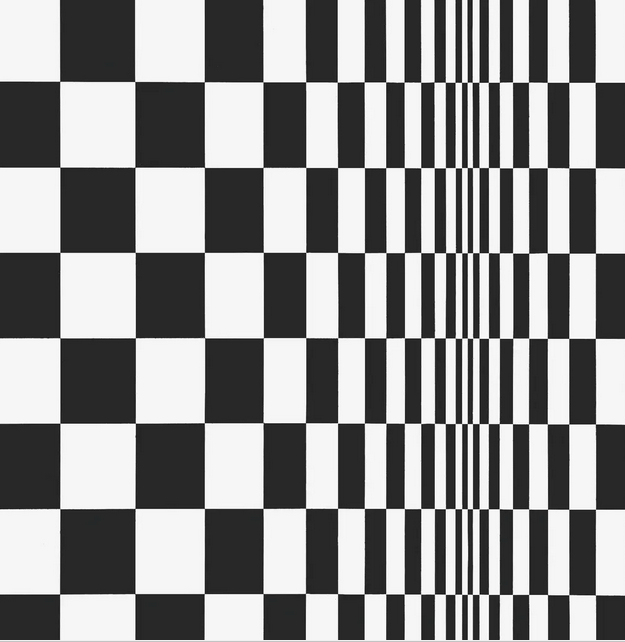 ate as they are viewed as, e.g., in Bridget Riley’s Movement in Squares (1961, left).
ate as they are viewed as, e.g., in Bridget Riley’s Movement in Squares (1961, left).
Assemblage: Assemblage was another influential art form and transformative step from this period. It had its origins in the Cubist constructions of Picasso and Braque, and the Dadaist works of Kurt Schwitters, and Duchamp (e.g., Fountain, 1917), although the term itself was invented in the 1950s. It is a three dimensional version of collage, producing artworks by assembling ‘found-objects’, ‘ready-mades’, and other bits and pieces in (allegedly) interesting ways.
Monogram: An ‘iconic’ example is Robert Rauschenberg’s Monogram (1955-59, below), a ‘combine’, featuring a stuffed goat with a paint-splattered face, wrapped in a car tyre and standing on a collage.

On the basis of such work, Rauschenberg received the 1995 Leonardo da Vinci Award ‘in recognition of his more than 40 years of fruitful artmaking.’
Pop Art: Pop Art was the last major visual art movement of the 20th century and a primary transformative force whose success vividly illuminates the state of contemporary art around the time Clark was completing Civilisation. Pop Art took the Dadaist principle that ‘found objects’ were a legitimate basis for assemblage art, and applied it to painting. Just as modern consumer society produces masses of material objects and junk that can be used for assemblages, so it also produces a massive reservoir of commercial and industrial images that can be used for pictures. Moreover, these ready-made images are likely to be quite striking as they are the productions of skilful graphic artists working in advertising and design. The pioneer Pop artist, Roy Lichtenstein, plundered the comics for powerful images in the early 1960s, and his very effective Whaam (1963, below) gets all its power from this parasitic strategy.
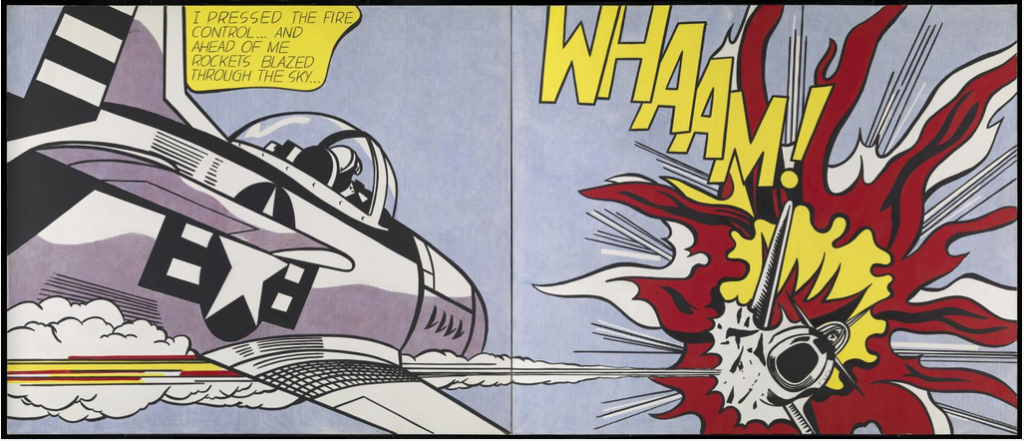
Origins: Pop Art emerged as a movement in Britain and America during the 1950s. However, the collage, I was a Rich Man’s Plaything (1947) by the Scottish-Italian sculptor, Eduardo Paolozzi, is considered to be the first example of the style and also the first to feature the word ‘pop’.
Hamilton: Another British artist, Richard Hamilton, produced one of the earliest (and more amusing) Pop Art productions. Once again targeting the banal promises of consumer society, Just what is it that makes today’s homes so different, so appealing? was a collage (below) created for the ‘This Is Tomorrow’ exhibition held in London in 1956.

‘Challenging Elitism’: Along with this theoretical rationale, Pop Art adopted the standard Modernist ‘outsider’ paradigm: it claimed that its aim is to ‘challenge’ traditional art by avoiding allegedly ‘elitist’ art subjects. Instead, it focuses on images found in the mass media and popular culture, especially in advertising, packaging, magazines, and comic books. Its alleged aim is parody and irony, purportedly emphasizing the banality, cheesy, and kitschy qualities of this source material.
High Art? However, it seems Pop Art just reproduces these commonplace qualities while using the politics and prestige of the art system to elevate the images to the status of ‘high art’ that they never aspired to. Similarly, the dynamism and form of a Pop Art piece may be derived entirely from the source material, with the ‘artist’ contributing little or nothing to the image, aside from providing it with its new status and theoretical justification.
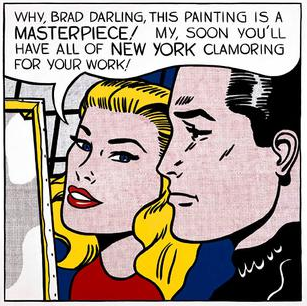 A $225 million Masterpiece: Another excellent example of Pop Art’s systematic appropriation of commercial art as the basis of ‘high art’ pieces is the history of Lichtenstein’s Masterpiece (1962, right). His work had already become the subject of intense criticism when it first appeared, with Life magazine even running a story asking ‘Is He the Worst Artist in the U.S.?’ Masterpiece was Lichtenstein’s response, and was very prescient: a simple design taken (of course) from a comic, it ridiculed the critics, and eventually sold in 2017 for A$225 million.
A $225 million Masterpiece: Another excellent example of Pop Art’s systematic appropriation of commercial art as the basis of ‘high art’ pieces is the history of Lichtenstein’s Masterpiece (1962, right). His work had already become the subject of intense criticism when it first appeared, with Life magazine even running a story asking ‘Is He the Worst Artist in the U.S.?’ Masterpiece was Lichtenstein’s response, and was very prescient: a simple design taken (of course) from a comic, it ridiculed the critics, and eventually sold in 2017 for A$225 million.
Warhol: Nobody personifies Pop Art better than Andy Warhol. Trained and employed as a commercial illustrator, he began exhibiting prints in the late 1950s. These appeared to be providing a commentary on America’s consumer culture and obsession with celebrities. Famous early works include Campbell’s Soup Cans (1962) and the Marilyn Diptych (1962). Finding a lot of interest in his work, Warhol diversified into a variety of artistic media, including silk-screening, painting, photography, sculpture and film.
The Factory & 15 Minutes of Fame: Warhol opened a big studio in New York. He called it ‘The Factory’ to emphasize the deliberately industrial nature of the work he was producing, employing a staff of assistants, while he himself wanted to become a ‘machine’. Inevitably, he became exceptionally fashionable and The Factory became an essential ‘place-to-be-seen’ for intellectuals, actors, poets, novelists, playwrights, celebrities, the gay sub-culture, drag queens and bohemian folk, all mingling with his wealthy and adoring patrons. It was on the basis of this experience that he coined the ‘law’ of modern society that ‘everyone will have 15 minutes of fame’.
Films: Aside from print-making and other forms of pictorial art, Warhol also produced innumerable films, focussing on the tedium of life or the activities of marginal groups, or both. Such films include Sleep, which records someone sleeping for six hours; Empire shows the Empire State Building for eight hours; and Eat, which shows a man eating a mushroom for 45 minutes. Warhol also felt it worthwhile to document himself eating a hamburger. Another film documents a participant’s face during a prolonged sexual encounter.
Symptomatic: Warhol was the most influential artist and cultural entrepreneur of the second half of the 20th century. He has been the subject of numerous retrospective exhibitions, book-length studies, and documentaries, and all artworks connected with him are very valuable, e.g., one of his prints, Silver Car Crash (1963, below) sold for A$135 million in 2013, while Eight Elvises reaped A$128 million paid.

Protest Art: There was a natural affinity between Pop Art and the anti-Vietnam-War protest art, especially with screen-printed posters, which appeared in the hundreds of thousands. Some of these used classic images as their basis, e.g., Michelangelo’s Pieta (1499), and Saturn Devouring His Son (1819-23) by Francisco Goya. As with Pop Art generally, they derived their power from their source material. They also 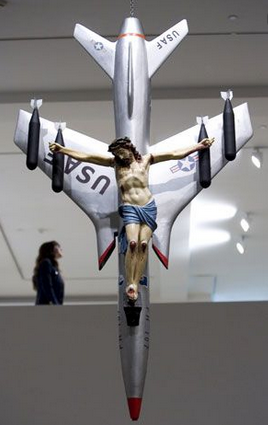 reinforced the ideological takeover of art.
reinforced the ideological takeover of art.
Anti-War Assemblage: There were also many one-off anti-war Pop Art works that sought the same affect, deriving their impact from traditional themes. These included León Ferrari’s famous ironic Crucifixion assemblage, Western-Christian Civilization (1965, left).
Australian Anxiety Australian artists trailed along behind these overseas trends. They were caught up in the cultural and political turmoil, but they also suffered from an ‘anxiety of influence’, i.e., a desire to insist on their own originality and freedom from outside influences. However, they couldn’t ignore these successful foreign trends and felt compelled to pursue them. They were also anxious to dethrone older generation masters like Sidney Nolan, Arthur Boyd, John Brack, etc., and establish themselves as the leaders of the local scene. Consequently, they quickly adopted the overseas styles.
‘The Field’: To make this clear, 52 years ago, just as Civilisation was appearing, a special exhibition called 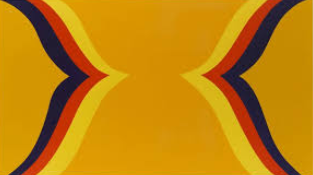 ‘The Field’ was held at the NGV. This realised in the Antipodes Clark’s worst fears about abstraction in art. It was expressly designed to showcase the work of the ambitious new generation, and their older rivals were deliberately not invited to exhibit. Typical works included Sydney Ball, Isfahan (1967, right); Dale Hickey, Untitled (1967); and Dick Watkins, October (1967). Predictably, the exhibition was a dull re-hash of overseas ideas, and revealed a severe poverty of ideas.
‘The Field’ was held at the NGV. This realised in the Antipodes Clark’s worst fears about abstraction in art. It was expressly designed to showcase the work of the ambitious new generation, and their older rivals were deliberately not invited to exhibit. Typical works included Sydney Ball, Isfahan (1967, right); Dale Hickey, Untitled (1967); and Dick Watkins, October (1967). Predictably, the exhibition was a dull re-hash of overseas ideas, and revealed a severe poverty of ideas.
Poverty: ‘The Field’ exhibition was mounted just as Clark was completing work on Civilisation. The Australian artists featured in it, along with Warhol, Rauschenberg, Lichtenstein, etc. exemplified the state of art around 1968. There was a widespread sense that art had become impoverished, in both ideas and execution. As one art historian observed in 1969:
The visual arts are showing distinct signs of weariness, as if we were approaching the end of something.
Indeed, the shift to Conceptual and Minimalist art (e.g., Peter Booth, Untitled, 1972, left) seemed almost ‘an attempt to abolish art itself.’ (Edward Lucie-Smith, Movements in Art Since 1945, pp.267-73)

Death of the Avant-Garde: Moreover, art had lost the central role it had enjoyed for centuries in the vanguard of cultural change. Indeed,
art is behind or barely abreast of the times, not ahead of them
as the avant-garde had previously prided itself as being. Art has dissolved into its diverse component parts and there was no longer any centre, as Clark lamented in Civilisation. Indeed,
the very notion of a dominant aesthetic style [was] outmoded [and] without any orthodoxy to resist there can be no avant-garde.’ (Kelly Grovier, Art Since 1989, 2015, pp.7-11)
What was left was a pseudo-avant-garde, that plays at being at the forefront of cultural evolution but is really just a pampered elite of doubtful talent sustained by government funding.
Dissolution: Art’s retreat from the cultural centre stage continued over the following decades as it entered further into the present era of dissolution, once again as Clark foretold. At the start of the new millennium, another art historian lamented:
What is immediately noticeable about today’s art … is an unprecedented profusion of styles, forms, practices, and agendas … The more one sees, the less certain one can be about what allows works to be designated ‘art’ at all’ (Michael Archer, Art Since 1960, 2002, p.7).
Art can now be ‘made’ from paint, metal, stone, air, light, sound, words, people, food, multi-media technology, junk, and refuse.
Disconnected: Art can also be made out of kitchen utensils, as Rosalie Gascoigne, Set Up (1984); and Subodh Gupta, Everyday Divine illustrate. It can even be made out of nothing, e.g., John Baldessari, Everything is purged from this painting but art; no ideas have entered this work (1966-8). Here, the entire content of the work (below) is contained in its title.
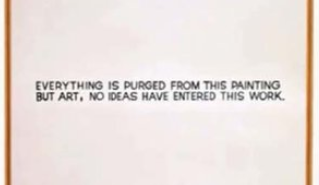
And who can forget, Bruce Nauman, Self-Portrait as a Fountain (1966-70). Overall, ‘no era in the history of human creativity has ever been so diverse in its vision or so seemingly disconnected’ from itself, from society, or from the tradition from which it has torn itself free. (Art Since 1989, pp.7-11),
The Perennial Quest: And so here we are, 50 years deeper into the Age of Modernity than when Clark presented his prescient assessment in Civilisation. Art has been transformed, and ours is an age where paint splashes, cartoon images, magazine scraps, screen prints of soup can labels, cutlery, pots and pans, posturing frauds, boring videos, and crucifixes in urine, are championed as works of art. It seems we have witnessed the eclipse of all of the aesthetic values that had previously sustained civilisation and it seems little of value has replaced them. Moreover, as Clark and his predecessor John Ruskin knew, such a cultural shift is symptomatic of a broader crisis, working its way through every aspect of society. However, as Clark demonstrated in our journey through the past 1500 years, civilisation has plumbed the abysmal depths before. And it has then pulled itself together, straightened up, and started out again on the ascent towards the Absolute, reaching out towards the ideals of Beauty and Truth to which true art has always aspired.
 Sign In
Sign In 0 Items (
0 Items ( Search
Search









I’d best pull Hegel from the shelf then and dust him off? Though, I think another ideal striving to the absolute will fail again when it confronts “the law of sin and death”, to resurrect a Paulinism. In fact, a rebirth is required, That would indicate the need for Divine intervention. Even the most heroic philosophical efforts will not resuscitate the corpse of Western Culture. Palingenesis is needed. That happens only to individuals, not nation-states or cultures. Spiritual life first, then truth and beauty will become nascent in the earth again. Briefly, The permanent fix is coming.
Mervyn, thanks for an informative, and for me, educative, run through the history of modern and recent art movements. Art both follows and leads culture, and currently it is clearly in a spot of bother. Yet good art still exists simply where people with technical skills and an ‘eye’ for aesthetic placement, colour and form turn something from their own experience and imagination into a shared emotion. Without this emotion and this sense of sharing, art is meaningless. So to those who wish art to merely reflect their political preferences without concern for imagination or aesthetics, I say go ahead if you must, but I won’t join you. Instead, I will turn to the artist who can bring me to their heights of passion or that poignant moment of stillness and vision, captured forever. Art will still live, despite its present suffocation under political correctness and funding scrambles. Soon we will cry loudly enough for something that is not what I still call ‘soviet’ art, that masquerade of art seemingly stifled in the service of the government of the day. Look at how artists of the past managed to re-imagine what their funders expected. Caravaggio, for instance. It will happen.
There is a statistic in “The Oxford History of the Twentieth Century” that always struck me. The book lists notable achievements for every year under various headings. Under “Culture”, the first 5 years of the century contain 29 entries, including: Conrad: Lord Jim, Heart of Darkness, and Nostromo; Chekov: Uncle Vanya, Three Sisters, and The Cherry Orchard; Puccini: Tosca and Madam Butterfly; Dvorak: Rusalka; Sibelius: Finlandia; Elgar: The Dream of Gerontius; Kipling: Kim; Rachmaninov: Piano Concerto No. 2; Debussy: Pelleas and Melisande; Bernard Shaw: Man and Superman; Frank Lloyd Wright completes Willits House, Illinois.
For the last 5 years recorded (1994-97) there is only one entry, “Tarantino: Pulp Fiction.”
Says it all really.
Farel, most of what is attributed to Hegel was actually the work of Fische, so go to the original.
Peter O’Brien my rational side agrees with you. The courts might poke around the edges but they won’t flip states. The Georgia recount will most likely be a fizzer because it’s probably just counting the same thing fraudulent votes again. Still, stranger things have happened.
But it’s probably a good time to start learning Chinese.
Sorry, wrong thread.